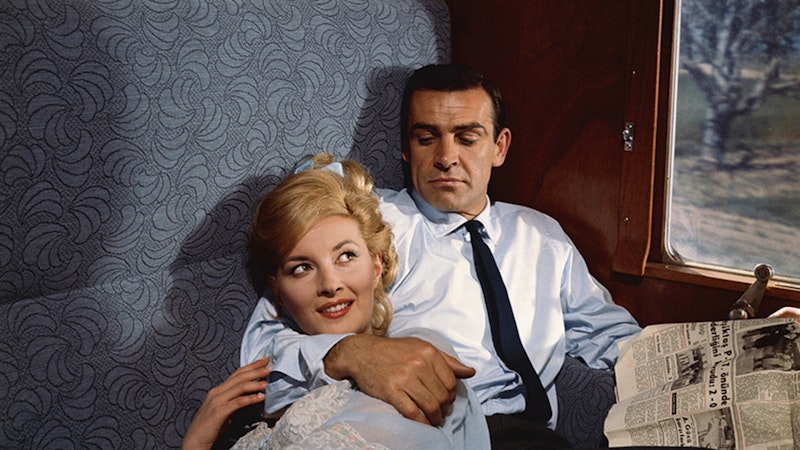Many claim the James Bond movies are best when grittiest, closest to the spirit of Ian Fleming’s original novels. 1963’s From Russia With Love, second in the series, is one of the more down-to-earth Bond films and widely considered one of the better ones. I don’t think it’s especially realistic, and as a result is a decent action movie.
It came the year after Dr. No, the first Bond film, and like that one was directed by Terence Young. The first scriptwriter to work on it was Len Deighton, who got nowhere and was replaced by Johanna Harwood, one of the writers of Dr. No. Young kept rewriting her and she was eventually replaced by Richard Maibaum, another Dr. No writer. Sean Connery was back as Bond, and so was the series’ secret weapon, editor Peter R. Hunt. The budget was larger, though still only $2 million, even in 1963 not a lot for a major motion picture. Nevertheless From Russia made even more at the box office than its predecessor.
The story: when evil secret society SPECTRE decides to destroy James Bond in revenge for his actions against them in Dr. No, one of SPECTRE’s Russian agents (Lotte Lenya) has a young clerk (Miss Universe runner-up Daniela Bianchi, dialogue dubbed by Barbara Jefford) at the Russian consulate in Istanbul contact the British, claiming she wants to defect with a Russian cryptography machine. The catch is that she’ll only turn herself and the machine over to James Bond personally, claiming she fell in love with Bond from reading his dossier. Bond goes to Istanbul, and has various close shaves with SPECTRE and Soviet assassins as he and the young defector make their way back to the West.
In outline it’s relatively faithful to Fleming’s From Russia, With Love (note comma) except for the use of SPECTRE—the book has the scheme entirely conceived by the Soviets. But other details are changed, too. Character introductions are more efficient. There’s a visually stylish if gimmicky opening sequence. The novel has a slow start with an overlong introduction to a Russian assassin and his backstory, then stultifying and badly-written scenes of Soviet politics; the film replaces those bits with melodramatic scenes involving the unseen master of SPECTRE, and a cartoonish sequence at a SPECTRE training camp. And action set-pieces not in the book are added near the end, making for a more satisfying climax.
The movie suffers from including the weaker elements from the book, notably a fetishized battle to the death between two Romany women. Thank heavens a troupe of Bulgarian assassins attacks. At any rate, there’s no equivalent to the mod weirdness of Doctor No’s lair, replaced here with much running-around Istanbul.
There’s a sense of cold-war tension, as Bond spies on the Russians and dodges assassins. But that’s undermined by the over-the-top SPECTRE sequences: a faceless evil mastermind, numbered agents, etc. A high-ranking SPECTRE operative’s given an elaborate introduction through a chess tournament, and then doesn’t do anything in particular and eventually is unceremoniously killed. The movie, trying to integrate this material into a straight-faced spy story, can’t help but turn it into kitsch.
With the relatively low budget it sometimes feels like a TV show. At about the time this film was made Ian Fleming was brought in to collaborate on the development of a show that became The Man From U.N.C.L.E. (he’d already worked on the early stages of the 1960 British series Danger Man); the Bond films were such big moneymakers they’d started a craze for super-spies which now feels very specific to the 1960s, and so today in slack moments the films can feel like cheap imitations of themselves. You notice how the beautiful defector Tatiana Romanova spends a physical afternoon with Bond and her makeup isn’t smudged.
Still, the sexual element in the film couldn’t have made it onto TV. At the time the movie was released American films were pushing against the restrictions of the MPAA’s production code; glimpses of near-nudity in this film and Dr. No were a sign of that new freedom, as were Bond’s double-entendres. And yet this isn’t a challenging film in any way. It follows the visual template of the first movie: sharp editing, deep-focus images of Istanbul, few close-ups. It worked for Dr. No and it works here, though as in that film some of the process photography effects are distractingly bad.
Connery’s acting is solid; as in Dr. No and many of his following Bond films, he gives Bond a kind of character arc not really in the script—he’s initially bemused by the situation he’s ordered into, then as people try to kill him he takes it increasingly personally. It’s a good way to give a subliminal sense of character to a movie that, at its best and most characteristic, is not interested in character.
More vital to the development of Bond is a piece of kit he’s given by his bosses: a trick briefcase with hidden compartments. It comes in handy near the end of the film, after a convincing fight scene in the cramped space of an Orient Express stateroom: the relatively realistic brawl gives way to the fancy gadget. It’s a foreshadowing of what’s to come in later movies. If the gizmos are bemoaned by many, they also gave the series a distinctive identity. They made Bond what he is today.
1963 was the year John le Carré published The Spy Who Came In From the Cold, a bleak, morally ambiguous spy novel that undermined the Bond style of escapism. Hard to view the Bond films as having any aspiration to realism after le Carré gave a glimpse of the dinginess of the espionage world. Maybe the producers agreed. After this one, they moved increasingly into the realm of sci-fi and pulp thrills, for worse or, as I think, for better.

